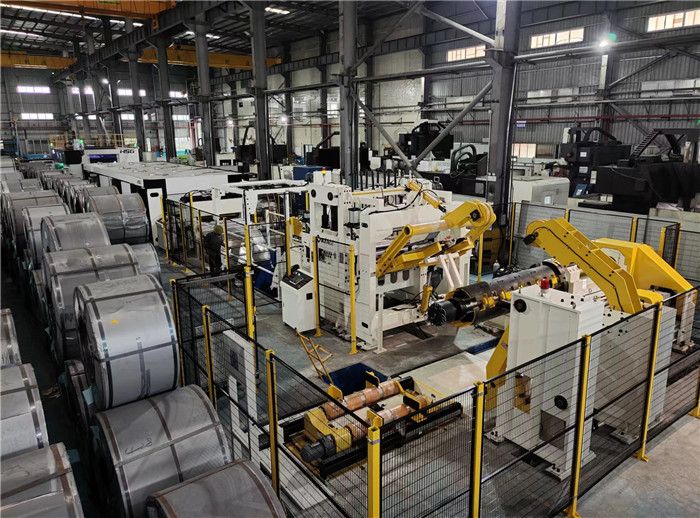Coil Feed Laser Blanking Line

Applicable material
Material Type: Cold rolled plate, Hot rolled pickling plate, High strength cold rolled plate, Galvanized plate, High strength hot rolled plate etc.
Material Thickness: 0.8-12.0mm
Coil Width: 200-1800mm
Yield strength: 245-980 N/mm2
Tensile Strength: 392-1180 N/mm2
Coil inner diameter: Φ610mm
Coil outer diameter: Φ1200-Φ1800mm
Loading weight: 20000KG
Feature Of Coil Feed Laser Blanking Line
Cost Saving
Usually the laser blanking line combination of a coil feeding line, and a fiber laser machine. Now the industrial fragmentation is more and more serious, less quantitative orders, so it does not need to mass production, more and more manufacturers tend to buy laser blanking lines, one line can produce a variety of products that need to be cut, compared with the stamping line, greatly save the cost of buying progressive dies.
More flexible and efficient production
Laser blanking lines provide finished laser-cut parts directly from a coil, leading to more flexible and efficient production. Compared with blank feeding systems, it offers many advantages due to the use of coils, for example, saving raw materials due to its better material efficiency, stable working rate and lower cost.
Power consumption Reduce
Laser blanking technology also reduces power consumption compared to the coil feed processing line.
Three Types Of Press Blanking Line
1. The sperate decoiler, straightener, and NC servo feeder machine match the laser machine
2. The combined decoiler and straightener and NC servo feeder machine matches the laser machine
3. Compact coil feed line matches laser machine.
Components and Processes
A coil feed laser blanking line is an advanced industrial manufacturing system used for high-speed and precision cutting of metal sheets or coils into specific shapes or blanks. It combines the advantages of coil feeding technology and laser cutting technology to achieve efficient and accurate production in various industries, such as automotive, aerospace, and appliance manufacturing.
Here's a breakdown of the key components and processes involved in a coil feed laser blanking line:
Coil Feeding: The process begins with a metal coil, typically made of steel, being unwound and fed into the system. The coil may be stored on a reel or a decoiler, which allows for continuous feeding without interruptions.
Straightening and Leveling: To ensure the material is flat and properly aligned, the coil passes through straightening and leveling equipment. This process removes any distortions or imperfections in the coil.
Servo Roll Feed: The straightened coil is then fed into a servo roll feed, which precisely controls the movement of the metal sheet. This mechanism ensures accurate positioning and feeding of the material to the cutting area.
Laser Cutting: A high-power laser cutting system is employed to cut the metal sheet or coil into desired shapes or blanks. The laser beam is guided by computer numerical control (CNC) to follow a predefined cutting path, determined by the desired design or pattern.
Scrap Removal: As the laser cuts through the metal, the excess material or scrap is separated from the main sheet. Various methods, such as suction or magnetic systems, are used to remove the scrap from the cutting area.
Sorting and Stacking: Once the blanks are cut, they are sorted and stacked according to the production requirements. This can be done automatically using robotic systems or manually by operators.
Quality Control: Throughout the process, quality control measures are implemented to ensure the accuracy and integrity of the produced blanks. This may include automated inspections using vision systems or manual checks by operators.
Coil Changeover: When the current coil is depleted, the system can be set up for a coil changeover. This involves stopping the line, removing the empty coil, and installing a new one.
The coil feed laser blanking line offers several advantages over traditional blanking methods, such as increased productivity, reduced material waste, improved flexibility in design, and enhanced precision. It allows for the production of complex and intricate shapes with minimal tooling requirements and faster production cycles.
Video For Coil Feed Laser Blanking Line


